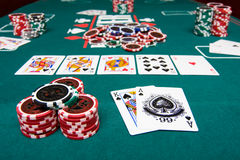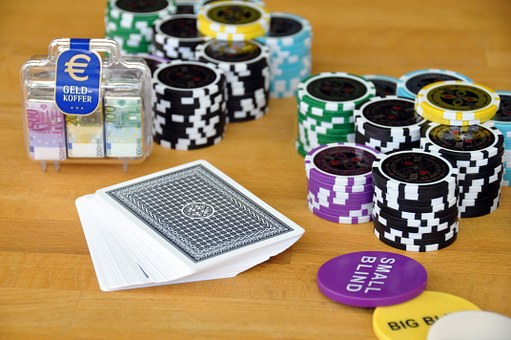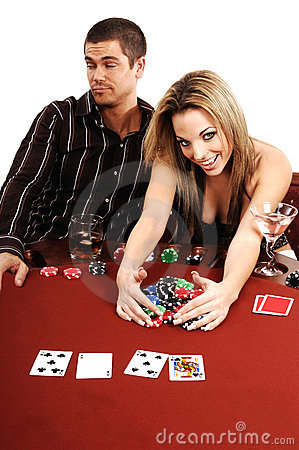
Texas Hold’em Poker is definitely the most popular variation of poker played around the world. In fact, many people not familiar with poker, think this is the only type of poker played. More and more people want to learn the game because of it’s popularity on TV. It’s well known that the top professional players earn millions playing a simple looking game, so why can’t the average person win a few bucks also? It seems like such a simple game.
Starting Rules

- In casinos and card rooms, the dealer doesn’t play. In home games, the dealer duty usually changes clockwise with each hand
- The player to the immediate left of the dealer acts first. The player to act first is at a definite disadvantage because they have no idea as to what the other players may do
- At casinos, there will be a “dealer” button that moves with each hand played, so play will rotate fairly
- There are 2 forced bets called blinds. They are the small blind and the big blind. Games begin with the two players left of the dealer making these predetermined blind bets. This is to insure there is always something (a pot of money) to play for in each hand. This is also why the dealer button moves every hand, because it wouldn’t be fair for the 1st two seats to always have to put in the two blinds
- The small blind is usually ½ of the minimum bet and the big blind is usually the full minimum bet. So, when you see a $1/$2 Hold’em table, that means the small blind is $1 and the big blind is $2.

The object of the game is to combine your hole cards with the 5 cards eventually dealt in front of the dealer, known as the “board,” to make the best poker hand at the table. The hand can contain your 2 hole cards and 3 board cards, 1 hole card and 4 board cards, or neither hole card and just the 5 board cards.
PLAY OF THE HAND

The Deal
Each player is dealt 2 cards face down, called the “hole cards.” You cannot let the other players see your cards and therefore they are to be checked discretely. No board cards are dealt yet.
First Betting Round
The 1st player to act is the 1st player left of the big blind spot, because the blinds have already bet in that sense. The player may fold, call or raise.
To fold, the player pushes his cards face down towards the middle of the table, called a muck, and is out of the hand.
To call, the player matches the big blind bet.
To raise, the player bets at least double the big blind bet. If he decides to bet all his remaining chips, it’s know as “all-in.”
Play continues clockwise around the table, with each player making the choice of fold, call or raise, with the same rules in play. As betting continues around the table, a raise is actually called a re-raise at that point.
THE FLOP
After the end of the 1st round of betting, the dealer “burns” (discards) the top card of the deck, just in case it was accidently seen, then proceeds to place the next 3 cards face up on the table in front of him. This is the flop.
Second Betting Round
This starts with the 1st player to the dealer’s left, since there are no more forced bets.
After the flop, the option of “check” is now available. This is like taking a pass. You can stay in the hand without betting additional money.
If everybody checks, that round is over and everyone gets to see a free card.
If someone bets, then all players must either fold, call or raise.
You cannot check if a player has made a bet before you. If a bet is made before you, you must fold, call or raise.
THE TURN (4th Street)
Once again, the dealer burns the top card and deals the next card to the table, called the turn or 4th street.
Third Betting Round
The betting again begins with the player immediately to the left of the dealer. The same betting rules used in the second round, apply in the 3rd round.
THE RIVER (5th Street)
The dealer burns the top card and deals the next (and last) card to the table in front of him, called the river or 5th street.
Fourth Betting Round
Same betting rules apply as in the previous betting rounds, with the player to the dealer’s left, starting.
THE SHOWDOWN
This is where it gets exciting. The last player to bet or raise shows their hand first and the highest five-card hand wins the pot. In case of a tie, the pot is evenly split among the winning hands.

Hands don’t always reach the showdown. In any betting round, if a player bets and everybody else folds, that betting player wins the pot without having to show his hand.
HANDS RANKINGS
- Royal Flush — five cards of the same suit, ranked ace through ten; e.g., A♥K♥Q♥J♥10♥
- Straight Flush — five cards of the same suit and consecutively ranked; e.g., 9♣8♣7♣6♣5♣
- Four of a Kind — four cards of the same rank; e.g., Q♣Q♥Q♦Q♠4♦
- Full House — three cards of the same rank and two more cards of the same rank; e.g., J♣J♥J♠8♦8♥
- Flush — any five cards of the same suit; e.g., A♠J♠8♠5♠2♠
- Straight — any five cards consecutively ranked; e.g., Q♣J♦10♥9♠8♦
- Three of a Kind — three cards of the same rank; e.g., 8♣8♠8♦K♣4♥
- Two Pair — two cards of the same rank and two more cards of the same rank; e.g., A♠A♣J♦J♣7♠
- One Pair — two cards of the same rank; e.g., 10♥10♣9♥4♦2♦
- High Card — five unmatched cards; e.g., A♣J♦10♠5♣2♥ would be called “ace-high”
FINAL THOUGHTS
Texas hold’em poker is not very difficult to learn, but it is quite difficult to master. I’ve only given the basic outline and rules of the game here. There are a vast number of possible game situations that can challenge players of the highest levels. Even the winningest pros say they are always learning to play better. Remember it is a game of chance, you can’t win all the time. Play responsibly.



